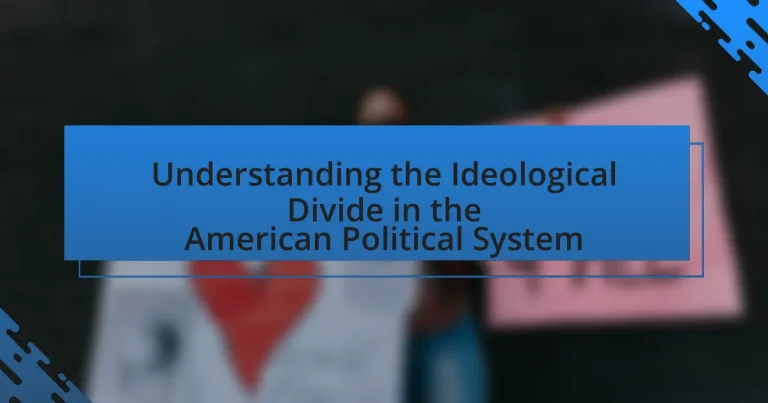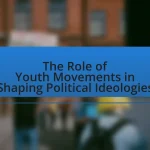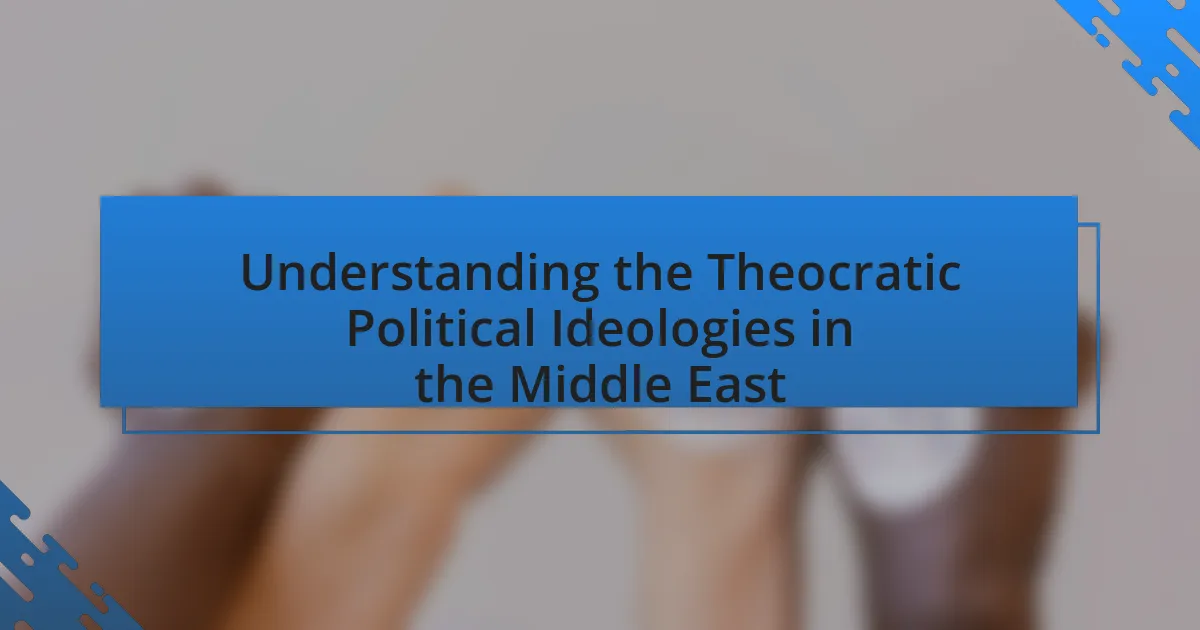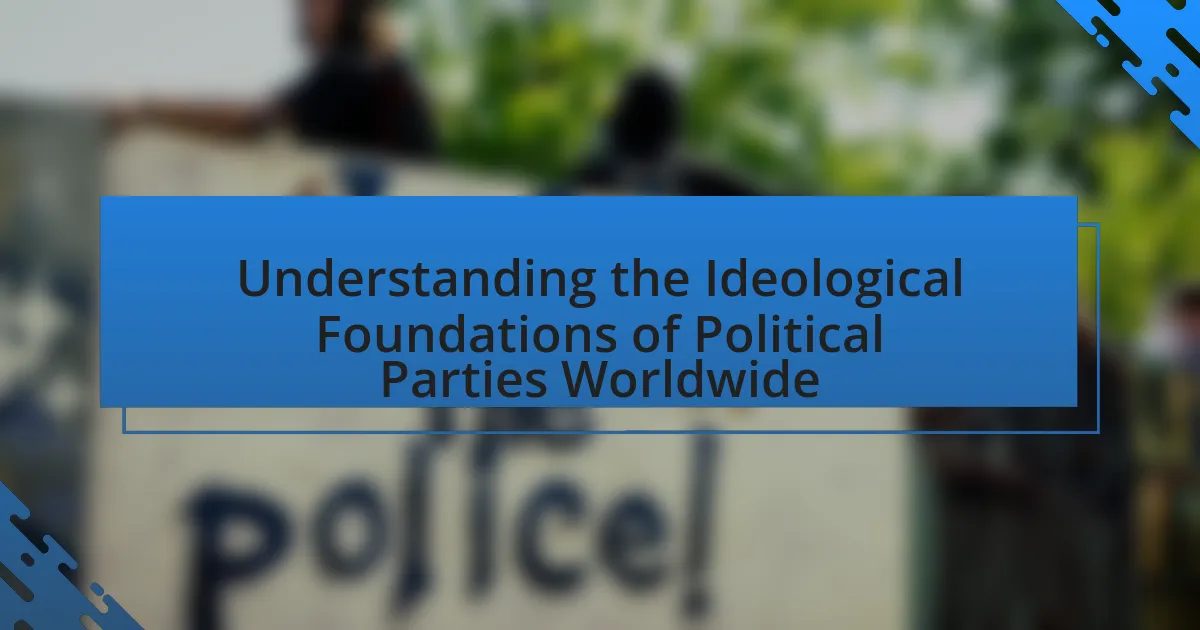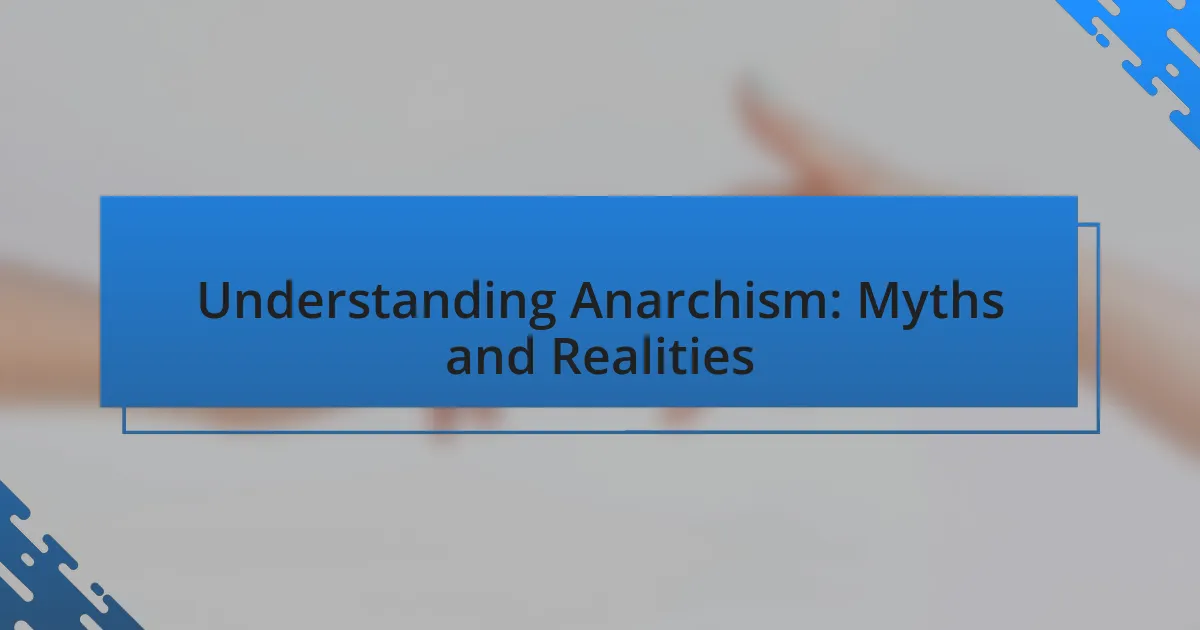The ideological divide in the American political system highlights the stark differences in beliefs and values between the Democratic and Republican parties, influencing various policy areas such as economic policy and social issues. This divide has evolved over time through historical events like the Civil War, the New Deal, and the Civil Rights Movement, leading to entrenched partisan polarization. Key political movements and ideologies, including liberalism, conservatism, and progressivism, further shape the landscape, affecting voter behavior and legislative processes. The article examines the implications of this divide on governance, the role of third parties, and strategies for fostering dialogue and understanding among differing ideologies.
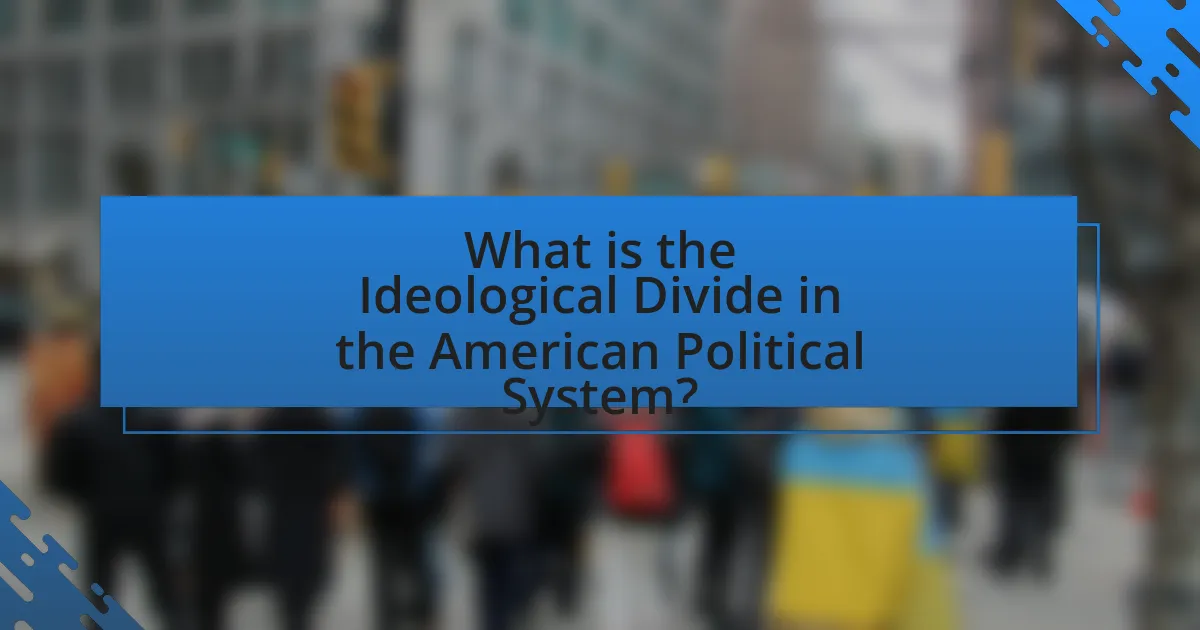
What is the Ideological Divide in the American Political System?
The ideological divide in the American political system refers to the significant differences in beliefs and values between the two dominant political parties: the Democratic Party and the Republican Party. This divide manifests in various policy areas, including economic policy, social issues, and government intervention. For example, Democrats typically advocate for progressive taxation and social welfare programs, while Republicans often support lower taxes and limited government involvement in the economy. This polarization has been documented in studies, such as the Pew Research Center’s analysis, which shows increasing ideological consistency among party members over the past few decades, leading to heightened partisanship and reduced bipartisan cooperation.
How did the ideological divide develop over time?
The ideological divide in the American political system developed over time through a series of historical events and shifts in public opinion. Initially, the divide emerged in the early years of the republic, with Federalists advocating for a strong central government while Anti-Federalists favored states’ rights. This foundational conflict set the stage for future ideological battles.
As the nation expanded, issues such as slavery and economic policy intensified the divide, particularly during the 19th century. The Civil War solidified the ideological split, with the Republican Party emerging as the party of abolition and the Democrats largely representing Southern interests.
In the 20th century, the New Deal era introduced a significant shift, as Democrats embraced a more active role for government in economic regulation, contrasting with the Republicans’ emphasis on limited government. The civil rights movement further polarized the parties, with Democrats increasingly aligning with progressive social policies while Republicans appealed to conservative values.
By the late 20th century, the ideological divide had become entrenched, characterized by a stark contrast between liberal and conservative ideologies on issues such as healthcare, taxation, and social justice. This ongoing polarization has been documented in various studies, including research by the Pew Research Center, which highlights the growing ideological consistency and partisan animosity among American voters.
What historical events contributed to the current ideological divide?
The historical events that contributed to the current ideological divide include the Civil War, the New Deal, and the Civil Rights Movement. The Civil War (1861-1865) established a fundamental divide over issues of slavery and states’ rights, leading to long-lasting regional and ideological differences. The New Deal in the 1930s expanded the role of the federal government in economic matters, creating a divide between those who supported government intervention and those who favored limited government. The Civil Rights Movement of the 1960s further polarized opinions, as it challenged existing social norms and prompted backlash from conservative factions. These events collectively shaped the ideological landscape of contemporary American politics, influencing party alignment and voter behavior.
How have key political movements shaped the ideological landscape?
Key political movements have significantly shaped the ideological landscape by introducing new ideas and altering public perceptions on various issues. For instance, the Civil Rights Movement of the 1960s challenged systemic racism and led to the establishment of laws promoting equality, thereby shifting the ideological focus towards social justice and civil liberties. Similarly, the feminist movement has redefined gender roles and advocated for women’s rights, influencing policies related to gender equality and reproductive rights. The rise of the Tea Party in the late 2000s emphasized limited government and fiscal conservatism, reshaping the Republican Party’s platform and attracting a new base of supporters. Each of these movements has not only mobilized grassroots activism but also prompted legislative changes that reflect evolving societal values, thereby continuously transforming the ideological divide within the American political system.
What are the main ideologies present in the American political system?
The main ideologies present in the American political system are liberalism, conservatism, and progressivism. Liberalism emphasizes individual rights, social justice, and government intervention in the economy to address inequality. Conservatism prioritizes tradition, limited government, and free-market principles, advocating for personal responsibility and minimal state intervention. Progressivism seeks to reform social and political systems to promote equity and environmental sustainability, often supporting more extensive government action. These ideologies shape policy debates and electoral outcomes, reflecting the diverse perspectives within American society.
What defines liberalism in the context of American politics?
Liberalism in the context of American politics is defined by its advocacy for individual rights, social equality, and government intervention in the economy to address social injustices. This ideology emphasizes the protection of civil liberties, support for social programs, and the belief in a mixed economy where both private enterprise and government play significant roles. Historical evidence of liberalism’s influence can be seen in landmark legislation such as the New Deal in the 1930s, which aimed to provide relief and reform during the Great Depression, and the Civil Rights Act of 1964, which sought to eliminate discrimination and promote equality. These examples illustrate how liberalism has shaped policies that prioritize social welfare and civil rights in American society.
How does conservatism differ from liberalism in the U.S.?
Conservatism in the U.S. emphasizes limited government, individual liberties, and traditional values, while liberalism advocates for a more active government role in economic regulation and social justice. Conservatives often prioritize free-market principles and personal responsibility, believing that minimal government intervention fosters economic growth. In contrast, liberals support government involvement to address social inequalities and provide public services, reflecting a belief in collective responsibility. Historical context shows that during the New Deal era, liberal policies expanded government roles in the economy, while conservative movements have often sought to reduce such roles, exemplified by the Reagan administration’s tax cuts and deregulation efforts.
What role do third parties play in the ideological divide?
Third parties contribute to the ideological divide by introducing alternative viewpoints that challenge the dominant two-party system. These parties often represent specific interests or ideologies that are not adequately addressed by the major parties, such as environmentalism or social justice. For instance, the Green Party has brought environmental issues to the forefront of political discourse, influencing the platforms of larger parties. Additionally, third parties can siphon votes away from major candidates, which can alter election outcomes and highlight ideological differences among the electorate. Historical examples include the impact of Ross Perot’s candidacy in the 1992 presidential election, which is believed to have affected the outcome by drawing votes from both major parties, thereby illustrating the significant role third parties play in shaping the ideological landscape.
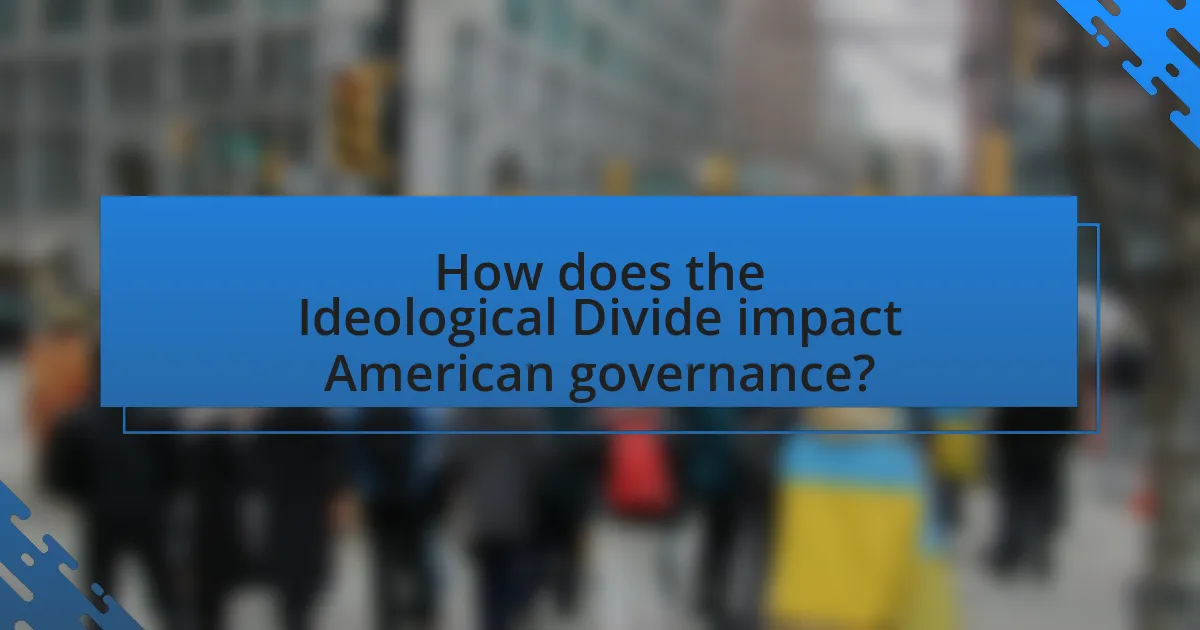
How does the Ideological Divide impact American governance?
The ideological divide significantly impacts American governance by creating polarization that hinders bipartisan cooperation. This divide manifests in legislative gridlock, where opposing parties struggle to reach consensus on key issues, such as healthcare and immigration reform. For instance, the inability to pass comprehensive immigration reform in recent years illustrates how ideological differences can stall critical policy advancements. Additionally, this polarization influences public opinion and voter behavior, often leading to extreme partisanship in elections, which further entrenches the divide. The result is a governance system that frequently prioritizes party loyalty over collaborative problem-solving, ultimately affecting the effectiveness of government operations.
What are the effects of the ideological divide on policymaking?
The ideological divide significantly hampers effective policymaking by creating polarization among lawmakers, leading to gridlock and inefficiency. This divide often results in parties prioritizing ideological purity over bipartisan cooperation, which can stall critical legislation. For instance, during the Obama administration, the ideological split contributed to the failure of comprehensive immigration reform, as partisan disagreements prevented consensus. Additionally, research from the Pew Research Center indicates that increased ideological polarization correlates with a decline in legislative productivity, as seen in the reduced number of bills passed in Congress over the past two decades.
How does partisanship influence legislative processes?
Partisanship significantly influences legislative processes by shaping the priorities, strategies, and outcomes of lawmaking. Political parties often align their legislative agendas with their ideological beliefs, leading to polarized debates and gridlock in Congress. For instance, during the Obama administration, partisan divisions resulted in significant delays in passing key legislation, such as the Affordable Care Act, which faced unified Republican opposition. This pattern of partisanship can lead to the prioritization of party loyalty over bipartisan cooperation, affecting the efficiency and effectiveness of governance.
What are the implications for bipartisan cooperation?
Bipartisan cooperation can lead to more effective governance and policy-making, as it encourages collaboration between opposing political parties. This collaboration can result in the passage of legislation that addresses pressing issues, such as healthcare and infrastructure, which often require broad support to be successful. Historical examples, such as the passage of the Affordable Care Act in 2010, demonstrate that bipartisan efforts can yield significant policy outcomes when both parties work together. Additionally, bipartisan cooperation can enhance public trust in government, as citizens often view collaborative efforts as a sign of political stability and responsiveness to their needs.
How does the ideological divide affect voter behavior?
The ideological divide significantly influences voter behavior by shaping party affiliation and electoral choices. Research indicates that individuals with strong ideological beliefs are more likely to align with political parties that reflect their values, leading to increased partisan loyalty. For instance, a study by Pew Research Center found that in the 2020 election, 94% of voters who identified as Democrats supported Joe Biden, while 93% of Republicans backed Donald Trump, illustrating how ideological alignment drives voting patterns. This polarization often results in voters prioritizing party loyalty over individual candidate qualities, further entrenching the divide in electoral outcomes.
What factors influence voter alignment with political ideologies?
Voter alignment with political ideologies is influenced by several key factors, including socioeconomic status, education level, and social identity. Socioeconomic status affects political preferences, as individuals from different income brackets often prioritize distinct issues; for instance, lower-income voters may lean towards ideologies that emphasize social welfare. Education level also plays a significant role, with higher education correlating with progressive ideologies, as educated individuals tend to engage more critically with political issues. Additionally, social identity factors such as race, gender, and religion shape ideological alignment, as these identities often dictate the political priorities and values individuals hold. Research indicates that these factors collectively contribute to the complex landscape of voter behavior and ideological alignment in the American political system.
How do media and social networks contribute to ideological polarization?
Media and social networks contribute to ideological polarization by creating echo chambers that reinforce existing beliefs and limit exposure to diverse viewpoints. Research indicates that algorithms on platforms like Facebook and Twitter prioritize content that aligns with users’ preferences, leading to a homogenous information environment. A study by the Pew Research Center found that individuals who primarily consume news from social media are more likely to hold extreme political views compared to those who engage with a variety of news sources. This selective exposure fosters an environment where opposing perspectives are marginalized, further entrenching ideological divides.
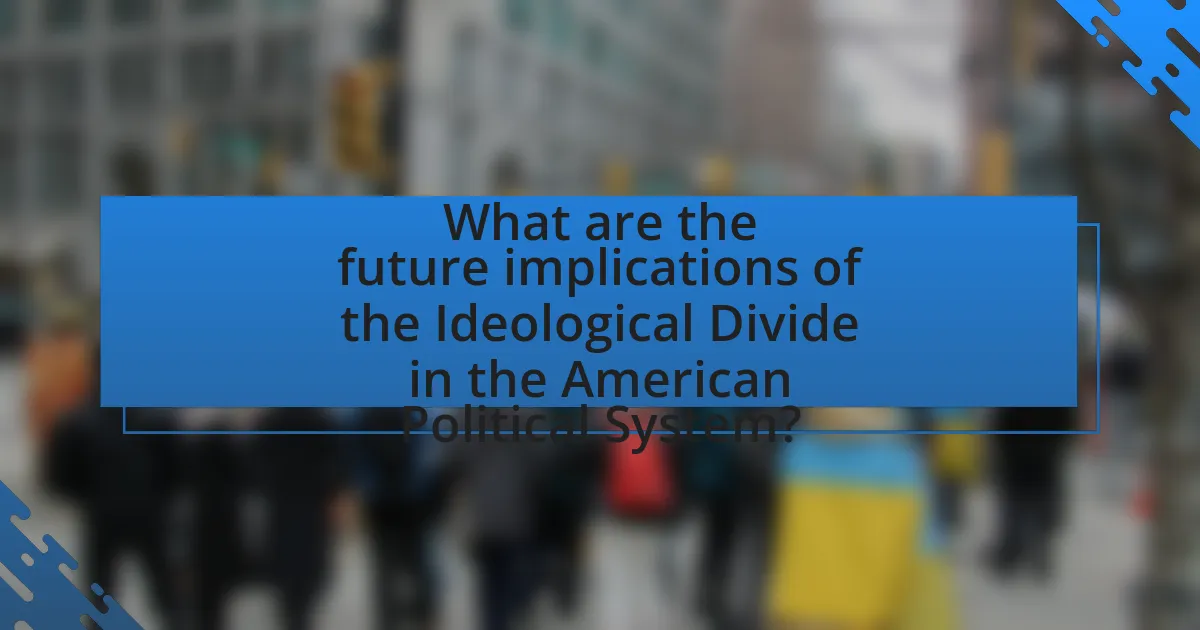
What are the future implications of the Ideological Divide in the American Political System?
The future implications of the ideological divide in the American political system include increased polarization, legislative gridlock, and challenges to democratic norms. As political parties become more ideologically distinct, collaboration across party lines diminishes, leading to difficulties in passing bipartisan legislation. Historical data shows that since the 1970s, the ideological distance between Democrats and Republicans has widened significantly, contributing to a rise in partisan conflict and a decrease in public trust in government institutions. This trend may result in a fragmented electorate, where extreme viewpoints dominate, potentially undermining the stability of democratic governance and fostering social unrest.
How might the ideological divide evolve in the coming years?
The ideological divide in the American political system is likely to deepen in the coming years due to increasing polarization driven by social media, demographic shifts, and divergent economic interests. Research indicates that social media platforms amplify extreme viewpoints, leading to echo chambers that reinforce existing beliefs and reduce exposure to opposing perspectives. Additionally, demographic changes, such as the growing diversity of the electorate, may exacerbate tensions as different groups advocate for distinct policy priorities. Economic disparities, highlighted by the widening wealth gap, further contribute to ideological divides, as individuals from varying socioeconomic backgrounds often have conflicting interests and priorities. These factors suggest a trajectory toward greater polarization rather than reconciliation in the political landscape.
What trends are emerging in American political ideology?
Emerging trends in American political ideology include increasing polarization, a rise in progressive values among younger voters, and a growing acceptance of diverse identities. Political polarization has intensified, with Democrats and Republicans becoming more ideologically distinct and less willing to compromise, as evidenced by a 2021 Pew Research Center study showing that 57% of Democrats and 49% of Republicans view the opposing party as a threat to the nation’s well-being. Additionally, younger voters are increasingly embracing progressive issues such as climate change and social justice, reflected in the 2020 election where 50% of voters aged 18-29 supported Joe Biden, who campaigned on progressive platforms. Lastly, there is a notable shift towards inclusivity, with more Americans identifying as part of the community and advocating for racial equity, indicating a broader acceptance of diverse identities within the political landscape.
How could demographic changes influence the ideological landscape?
Demographic changes can significantly influence the ideological landscape by altering the composition of the electorate and shifting political priorities. For instance, increasing diversity in the population, such as the growth of Hispanic and Asian communities in the United States, has led to a greater emphasis on issues like immigration reform and social justice, which are often championed by more progressive political factions. According to the U.S. Census Bureau, by 2045, it is projected that non-Hispanic whites will make up less than 50% of the U.S. population, which could further amplify the voices and concerns of minority groups in political discourse. This demographic shift can lead to a realignment of political parties, as they adapt to the changing values and needs of a more diverse electorate, potentially resulting in increased polarization or the emergence of new political movements.
What strategies can be employed to bridge the ideological divide?
To bridge the ideological divide, fostering open dialogue and promoting empathy are essential strategies. Open dialogue encourages individuals from differing ideological backgrounds to engage in conversations that prioritize understanding over winning arguments, which can reduce polarization. Research from the Pew Research Center indicates that when people engage in discussions with those holding opposing views, they often find common ground, leading to more constructive interactions. Promoting empathy involves encouraging individuals to consider the perspectives and experiences of others, which can humanize opposing viewpoints and reduce animosity. Studies show that empathy can lead to increased cooperation and decreased hostility, making it a powerful tool in bridging divides.
How can dialogue and compromise be fostered among differing ideologies?
Dialogue and compromise among differing ideologies can be fostered through structured communication platforms that encourage active listening and mutual respect. These platforms, such as town hall meetings or facilitated discussions, create safe spaces for individuals to express their views while also considering opposing perspectives. Research indicates that when participants engage in dialogue with a focus on shared values rather than divisive issues, they are more likely to find common ground. For instance, a study by the National Institute for Civil Discourse found that structured dialogue programs significantly improved participants’ willingness to compromise and understand differing viewpoints. This evidence supports the effectiveness of intentional dialogue in bridging ideological divides.
What role does education play in reducing ideological polarization?
Education plays a crucial role in reducing ideological polarization by fostering critical thinking and promoting exposure to diverse perspectives. Research indicates that higher levels of education correlate with increased tolerance for differing viewpoints, as educated individuals are more likely to engage in constructive dialogue and seek common ground. For instance, a study published in the journal “Political Behavior” by Campbell and Tuch (2016) found that individuals with a college education are less likely to hold extreme partisan views and more likely to support bipartisan solutions. This suggests that education not only equips individuals with analytical skills but also encourages empathy and understanding, which are essential for bridging ideological divides.
What practical steps can individuals take to understand and engage with the ideological divide?
Individuals can take several practical steps to understand and engage with the ideological divide. First, they should actively seek diverse perspectives by consuming media from various sources, including those that challenge their own beliefs. Research indicates that exposure to differing viewpoints can enhance critical thinking and empathy, as shown in studies by the Pew Research Center, which found that individuals who engage with a range of opinions are more likely to understand opposing viewpoints.
Second, participating in community discussions or forums can facilitate direct engagement with others holding different ideologies. Engaging in respectful dialogue allows individuals to articulate their views while also listening to others, fostering a more nuanced understanding of the ideological landscape.
Third, individuals can educate themselves on the historical and social contexts that shape current ideological divides. Understanding the roots of these divides, such as economic disparities or cultural shifts, can provide clarity on why certain beliefs are held. Academic literature, such as “The Righteous Mind” by Jonathan Haidt, emphasizes the importance of understanding moral foundations that underpin different ideologies.
Lastly, practicing active listening and empathy during conversations can help bridge gaps between opposing views. Research shows that empathetic engagement can reduce polarization and promote constructive dialogue, as highlighted in studies published in the Journal of Personality and Social Psychology. By implementing these steps, individuals can better navigate and engage with the ideological divide.
